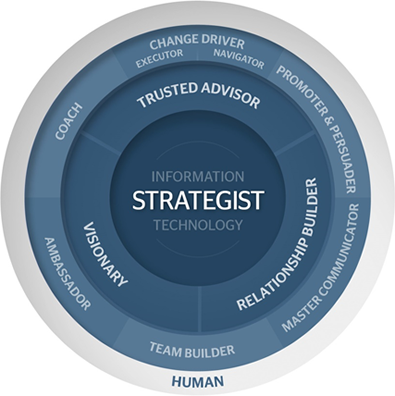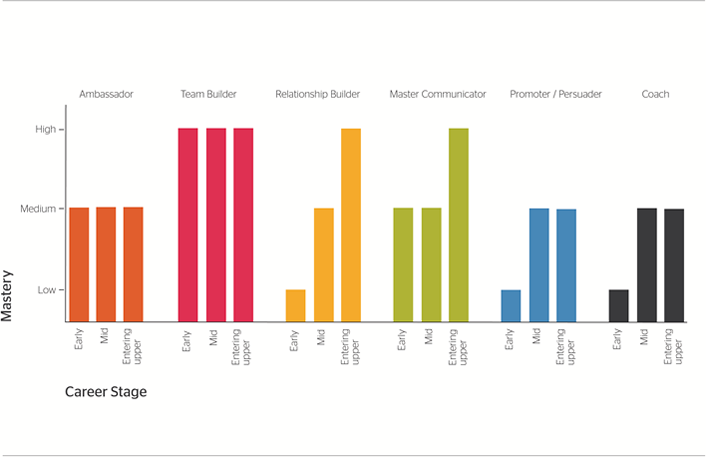Key Takeaways
- EDUCAUSE and Jisc collaborated to answer the question "How do we best prepare the next generation to lead?"
- The resulting report and pull-out guide provide practical steps that aspiring IT leaders and their managers can take to help mid-career staff progress to the next level.
- The advice offered includes six roles to learn and when to learn them, as well as the priority order of each step.
In 2015 EDUCAUSE and Jisc convened a new working group of 10 UK and U.S. IT leaders and challenged them to explore the question "How do we best prepare the next generation to lead?" Their work resulted in the February 2016 report and pull-out guide, Technology in Higher Education: Guiding Aspiring Leaders. This article is an excerpted version of that document.
Today's institutions need to adopt new models to stay competitive. They need to focus on outcomes, cost-effectiveness, and responsiveness. These needs have combined with the rapid development of technology across all layers of society and throughout the institution. The higher education IT leader stands at the center of all this change, holding a complex and demanding position that requires a range of skills. However, many aspiring technology leaders meet with difficulty in stepping up to a leadership role.
The rapid pace of change in technology and higher education alike mean the challenging role of the IT leader will continue to evolve in the coming years. It is crucial to do what we can to future-proof the profession by preparing tomorrow's higher education IT leaders now. In May 2015 EDUCAUSE and Jisc convened a working group of 10 UK and U.S. IT leaders to explore the question "How do we best prepare the next generation to lead?" This work followed an earlier collaboration between the two organizations to define the characteristics of the higher education technology leader, which resulted in a model shared in the March 2015 report Technology in Higher Education: Defining the Strategic Leader.
Although it is impossible to provide a single, clear pathway to IT leadership that can be universally applied in institutions of varying size and maturity, the 2016 report that resulted from the collaboration to provide guidance for aspiring IT leaders — Technology in Higher Education: Guiding Aspiring Leaders — summarizes the group's discussions over the course of the yearlong project, including — in the form of a pull-out guide — some practical steps that aspiring leaders and their managers can take to help mid-career staff progress to the next level. It focuses on three areas:
- Who in higher education IT would benefit most from training in leadership skills?
- What skills should be focused on?
- When in the career development of an individual should the skills be fostered?
Career Stages
- Early: Entry-level staff; skilled technical professionals
- Middle: Team leaders/supervisors; middle management, technical leads, architects
- Upper: Heads/directors; IT leaders/CIOs
Who
The working group chose to focus its attention on the middle stage of an IT professional's career. IT professionals at this stage should already have some sense of the career path that they would like to take and some awareness of whether they would be interested in moving into leadership.
Not all IT leaders originate in IT, and an organization might have many leaders — not everyone will want to or can become a CIO. Focusing on the mid-level professional allows development of leadership roles and skills that will be necessary for many kinds of leadership in the IT organization.
It is also at this middle stage where the most professional development growth is likely to occur — that is, where leadership training will be most useful and necessary and where the working group's guidance would be most effective. The advice aims to provide IT professionals at this stage with a clearer path and a sound understanding of the requirements of a leadership position.
What and When
What skills and experience do these aspiring leaders need to progress to an upper-stage IT leadership role? When will they need them? Some skills should already be in place, some would need to be developed, and others would need to be mastered. Of the 10 roles from the Model of IT Leadership described in Technology in Higher Education: Defining the Strategic Leader (see figure 1), six were identified as essential to have full or partial competency in to progress to a leadership position:
- Relationship Builder
- Master Communicator
- Promoter/Persuader
- Coach
- Team Builder
- Ambassador

Figure 1. Model of IT Leadership
Relationship Builder is a primary role, defined as needing time to develop and perhaps difficult to achieve. Primary roles are interdependent and the most valuable roles an IT leader plays. Whereas primary roles are typically ones that a successful IT leader uses consistently (and simultaneously), the other five discrete roles may only be needed at specific times. But which of the six roles should mid-career IT professionals prioritize? Ultimately, the development of these skills falls into a continuum rather than a black-and-white picture (see figure 2).

Figure 2. Continuum of skill development
Low Priority
As an IT professional entering the middle stage of your career, you will encounter some expectation that you can perform the following roles well. Only moderate continued development of these roles is expected as you progress through the middle stage to enter the upper stage.
- Ambassador: This role could be seen as more significant than other roles during early career stages when you might have more direct contact with end users. However, you are also an ambassador for your institution and the sector. You should work to continually demonstrate this skill.
- Team Builder: Your previous experience will help you fulfil this role a moderate to significant amount of time in this middle stage of your career. However, the notion of a "team" changes at different levels, and therefore it will continue to be an important role.
Medium Priority
Steady development of the necessary skills for these roles is a requirement before you can progress to a leadership position in the upper stage. However, expertise over these areas is not expected to occur until you have reached that stage.
- Promoter/Persuader: The most influential promoters include individuals with a network of contacts and relationships at the appropriate level, whether grassroots or senior management.
- Coach: As with other roles, coach is one that may not be required at the early stage, but you will be expected to spend significant portions of your time in this role before you progress to a leadership role.
High Priority
You will need to have developed significant skills to fulfil these roles at a high level by the end of the middle stage of your career. Further, of the six roles focused on in this stage, the greatest amount of skill development is expected for the following two roles. It is crucial for people looking to progress to the upper career stage to have well-developed skills to fulfil them.
- Relationship Builder: Good cross-functional relationships allow you to do good things, whereas poor relationships mean you are getting by, at best. You should develop this skill as soon as possible.
- Master Communicator: This is an essential trait of any IT leader, and staff who naturally have this skill, or develop it earlier, often tend to rise faster in their careers.
IT Leadership in Higher Education: A Guide to Skills Development
The brief guide included in the final report offers support and practical advice that can help prepare aspirants for the challenges of their first IT leadership role. It provides concrete steps to support the skill development needed to fulfil the following IT leadership roles: Ambassador, Team Builder, Relationship Builder, Master Communicator, Promoter/Persuader, and Coach. The guidance targets two groups:
- Aspiring leaders: What skills are necessary to fulfil these roles, and what support is needed to move forward?
- Current IT leaders: What should current IT leaders do to support their staff members' development?
Instilling leadership concepts into the IT organization impacts staff at all stages of their careers. This guide works with the following assumptions:
- Leadership can happen anywhere: Leadership can happen at any stage of your career. IT professionals can and should build and practice leadership skills throughout their careers, and IT organizations should encourage staff by introducing this concept early and providing a supportive environment to inspire leadership.
- IT is a culture of service: For IT to be a strategic player in higher education, and for staff to become strategic IT leaders, there has to be some common understanding of the nature of IT as a service organization.
- IT is of strategic importance: Emphasizing the strategic importance of IT is a responsibility for IT staff at all levels and particularly for IT leaders. But to do this well, staff need to understand the business of the organization and communicate the value of IT in helping meet institutional strategic objectives.
The guide provides an in-depth look at the six roles, including definitions for each role along with the skills needed to perform them. In addition, a skills assessment checklist gives IT professionals a way to rate current ability levels and helps identify which skills need further development. The results on the assessment can be used to help determine which support mechanisms are most useful. These mechanisms — recommended activities, experiences, strategies, and training — are provided, focusing on three areas:
- Coaching and mentoring: These development techniques use one-to-one discussions to enhance an individual's skills, knowledge, or work performance. Coaching typically involves a short-term relationship that focuses specifically on a task at hand and its outcome. Mentorships are usually long-term, collaborative relationships concerned with personal and career growth and development on a larger scale.
- Broadening experience: IT leaders must have a broad view of the institution and an understanding of the impact that IT can have on its users, in different departments, and in support of the institutional mission. A key way of gaining this insight is by looking for ways to broaden your experiences and to acquire new skills, knowledge, and experience in other departments/organizations.
- Training and professional development: These opportunities to equip aspiring leaders with necessary skills may range from in-depth cohort programs to shorter in-person or online training classes focusing on a specific skill.
Conclusion
Not enough work has been done to understand how to equip professionals for the kinds of roles IT leaders are expected to play in their day-to-day work. If current IT leaders face significant challenges, then it is likely that aspiring IT leaders in higher education find it tough to take on the roles we know are needed for IT leadership. So we began a new project, knowing from the outset that it would be a difficult topic to address and that we wouldn't find a simple or straightforward answer to our question of how to help prepare the next generation of IT leaders.
This project is another small step toward helping people think positively and take ownership of their careers in higher education IT, but the challenges they face will require continued support and attention from senior leaders. Topics needing additional exploration in the future, as partners and with our community, include:
- Retention: How do we ensure that aspiring technology leaders can build the necessary skills without moving to another organization or sector?
- Recruitment: How do we attract the right talent from both inside and outside higher education?
- Diversity: How do we ensure that our workforce is diverse in background, color, sex, and experience?
We invite others to join us in this effort and hope that our findings serve to stimulate further discussion and progress.
Karen A. Wetzel is program manager, ECAR Working Groups, EDUCAUSE.
© 2016 Karen A. Wetzel. The text of this EDUCAUSE Review article is licensed under the Creative Commons BY-NC-ND 4.0 International license.
